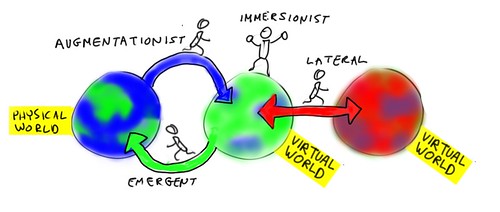In parts 1 and 2 of this series, I looked back at the evolution of automobiles and motion pictures to show how significant unanticipated personal and cultural changes emerge from new technologies. In today's post, I'm going to provide a brief summary of avatar-centric identity in 3D virtual worlds as an introduction to how our experience there might inform our discussion of pseudonymous identity within social networks.Shortly after my "birth" in Second Life, I began to extend my avatar identity to social networks. Over the next three and a half years my virtual life has moved almost entirely into the 2D virtual world of blogs, social networks and media sharing sites. The sketch above visualizes the movement of identities between multiple worlds.
- Augementationist Identity transfers wallet name identities into virtual environments. Facebook is probably the best example of a virtual community extending physical world relationships and identity.
- Immersionist Identity is born on an online platform and facilitates virtual lives which are distinct from physical world relationships and identities. Second Life culture is one of the most notable examples of this paradigm.
- Emergent Identity is born in a particular online platform and then extended to others, including environments with primarily physical world-identified communities.

In virtual worlds, pseudonymous identity can be thought of as a continuum ranging from the extension of physical identity on one pole, to the experience of a dissociated autonomous being on the other. The left end of the illustration above is the human aka avatar sphere. On the extreme left edge of the continuum, individuals create avatars that closely resemble their human forms as this recent Second Life banner advertisement illustrates.
Finally, some people experience their avatar identity as a unique personality that is distinct and independent from their human persona, like me! Although some people see this as a Multiple Personality Disorder, I prefer to think of it as a Multiple Personality Capability.
The emergence of a distinct virtual identity is rooted in the same processes and underlying biology that contribute to such variants of "normal" human personas. In the physical world, we express ourselves through a multiplicity of roles such as parent, employee, student, party goer, and so on. But the vast differences in our personas from role to role are barely noticed. The way we dress, the style and substance of our communication, and subconscious expression such as body language and posture can vary widely in different roles and settings.
Although living part of one’s life through an avatar identity seems strange to most people today who haven’t experienced it for themselves, I imagine people from just a few generations ago would find our mainstream world of pervasive texting and social networking to be equally as disturbing. Like seeing everyone in the crowd leaving a movie theater walking with heads down, eyes glued on their phones and oblivious to anyone else around them. Now that’s creepy.
One of the most valuable aspects of leading a distinct virtual life is its ability to expose aspects of physical life which are usually invisible to us. In part 4, I'll hack a bit deeper into virtual identity, including its relationship to creativity.


2 comments:
excellent and concise as usual.
Thank you for your thoughtful post! Like you, I have extended my presence from Second Life into the world of the flesh people (I have a Facebook page, a flickr feed and a YouTube feed), and at times I've wondered about the psychological impact on my "typist." I like the phrase "multiple personality capability"; it's very reassuring.
Post a Comment